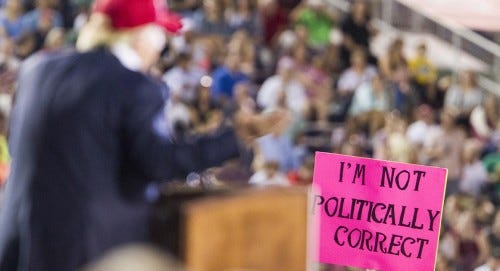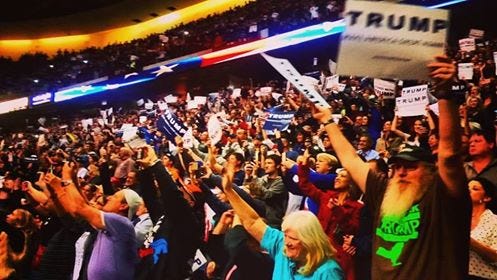The Silent Majority Stands With Trump
You’ve seen them.
Printed on a white background with varying shades of blue and red, the signs are invariably held by middle-aged men and women.
They’re waved in Donald Trump crowds alongside Confederate flags and dance in front of the stage while the billionaire speaks.
“The silent majority stands with Trump.”
Who are the silent majority? What does the term mean? And why are they coming out for Trump?
The answer has its roots in the intense white backlash to the Civil Rights Movement and the Civil Rights Act. It’s a throwback to the coalition that helped Richard Nixon rise to power in 1968, and has much of the same connotations of white backlash to racial change and civil rights.
Trump is tapping into that same coalition and ideology in his quest for the presidency. White backlash is back. And so is the silent majority.
[A]fter the Civil Rights Act of 1964, it appeared there was a real chance for racial justice and societal change in the US. The stain of Jim Crow in the South had hung over the country for so long that once it was gone, most Americans a supported the idea of shedding the sins of the past.
Once the law became a reality, though, it sparked a response from majority middle and lower class white people who were in the path of the integrative change. This “white backlash” would have long-lasting effects on the country’s political reality.
White resistance to the desegregation of neighborhoods and schools begot federal intervention under Eisenhower in the 1950s in the Deep South. By 1964, the Civil Rights movement had largely won those battles, and the codification of integration and equal rights into law created a new societal standard.
Integration expanded to the entire country, and with it, the white resistance. California whites fought integration with Proposition 14, an anti-integration measure that essentially re-legalized discrimination in housing. Even as late as the 1970s and 1980s, whites in Boston, MA and Yonkers, NY, would fight against integration policies.
The Civil Rights Act made these struggles against integration exercises in futility. No matter what tactics the white resistance employed, the end result was the same- state sanctioned discrimination based on race could not stand and would lose.
[I]n many cases, white backlash also took the form of white flight. Whites left the inner-city communities that were being “invaded” by people of color in droves. They headed to the more affluent suburbs; areas which were relatively protected by their wealth- the business classes that were helping integration along in the cities lived in the suburbs and would not allow integration to happen in their neighborhoods.
White flight and de facto segregation created an echo chamber for the strong right wing movement that had been building for the length of the 1950s and 1960s. In the suburbs, a hard right political philosophy was brewing. It was a mix of anger over integration, hippies, and secularism.
Meanwhile, the white backlash over the Civil Rights Movement was leaving many poorer, disadvantaged whites with a lot of anger and nowhere to channel it. Their population was caught between a rock and a hard place. The Civil Rights Act had shamed many into burying public displays of racism and hatred. Without this outlet, frustration began to build.
Indeed, the behavior of the politicians and people on the ground defending segregation in the South had shamed the entire region. It was no longer universally socially acceptable to support keeping people unequal based on the color of their skin.
[W]ith that shame came a sense of political betrayal. The South had dutifully supported Democrats more or less consistently since well before the Civil War. But it was a Democrat, from Texas no less, who had signed the Civil Rights Act and upended the entire Southern political system.
Whites in the South felt betrayed by their political leaders and impotent in the face of a changing America. The right wing was ideologically strong, but politically adrift. They needed a leader, and Richard Nixon emerged to fill that role.
Nixon’s presidential campaign in 1968 used the language of “the silent majority” to send a message to politically impotent whites: I stand with you. I will say what you feel you cannot.
The silent majority referred to the increasingly angry group of right wing whites that had watched their racial and economic supremacy become shaken by the Civil Rights Movement. This group had been “silent” for too long, the thinking went, but now they had an outlet for their political activism.
Nixon would go on to win election in ’68, using a combination of racially coded language and vague promises to combine the silent majority into a coalition with other conservatives and disgruntled working class whites.
The Nixonian presidency would not live up to its promise. The Californian’s second term was cut short by scandal, impeachment, and resignation. The silent majority was once again shamed and, of course, silenced.
[U]ntil now.
Make no mistake, today Trump is tapping into the same fears and concerns that Nixon did almost fifty years ago. White Americans have watched over the past seven years as their monopoly on the presidency and culture has been eroded by the presence of Barack Obama at the country’s helm.
Further, whites have seen the nation question the primacy in society of and trust in police officers in the wake of multiple publicized shootings of unarmed black men. The Black Lives Matter Movement threatens the carefully constructed paradigm of white supremacy and status that many white Americans rely on for strength and comfort.
Perhaps the unspoken fear is that BLM will, in time, become a new Civil Rights Movement and enforce equality at the expense of whites. Perhaps not. But the drive to suppress voting across the country for people of color and the poor indicates that the right wing does not want to allow for the possibility of change.
American society has moved forward in other ways that have upset and disrupted the “regular order.” Gay rights have moved at breakneck speed over the past decade to expand marriage to all Americans. Activists have called for accountability against rape and sexual violence on college campuses and beyond.
A changing society with shifting social mores has once again shamed the disenfranchised white American population into silence. This isn’t the way things were supposed to go- not after Reagan and Bush, and Bush, and Congressional dominance. But voting for politicians that promise to stop the march of progress in society is futile- the change will come to the public square no matter what they say.
And once again, speaking out in their anger against the changing society will result in public shame. The ideation of the silent majority is not being pulled from the past so much as it is being updated for a new disempowered population of whites whose modified supremacy in society is being eroded just as it was in the past.
Trump began speaking to this strain of American politics in July of 2015. The language was not a mistake. The support that Trump wants, and the support that his rivals want, is rooted in this modern day revival of the worst parts of conservatism in the late twentieth century.
The silent majority no longer wants to be silent. They’ve found their mouthpiece. They’re ready to speak out in their electoral voice. The question is, come Election Day; will that voice be loud enough to be heard?







